RBA Annual Conference – 1998 Dimensions, Structure and History of Australian Unemployment Jeff Borland and Steven Kennedy[*]
1. Introduction
It is commonly presumed that – with the exception of wartime – the Great Depression of the 1930s marked the low point in the level of well-being in industrial societies in the twentieth century. Certainly, there is much to support this presumption. As Figure 1 illustrates, there has been no other period in Australia where the rate of unemployment remained at such high levels for such a sustained length of time. However, it is also important to recognise that comparisons between the Great Depression and other periods are a matter of degree. The average rate of unemployment since the mid 1970s might not have been as high as during the Great Depression, but it is much closer to the average during that time than, for example, in the thirty years prior to the mid 1970s. Moreover, the current episode of mass unemployment must be considered by historical standards to have now persisted for a very long period. Viewed from this perspective there can be little doubt that unemployment should properly be regarded as the most significant economic and social problem currently facing policy-makers in Australia.
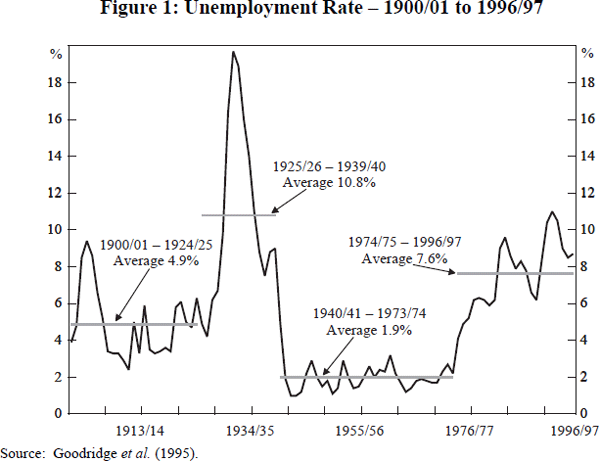
This paper provides an overview of the main features of unemployment in Australia, and its consequences. Its main objectives are to:
- describe the main features of the evolution and distribution of unemployment;
- present information on labour market outcomes underlying the changes in unemployment – with the aim of providing some insights into the nature of unemployment and its potential causes; and
- describe a range of consequences of unemployment.[1]
Section 2 describes the evolution of the rate of unemployment in Australia from the mid 1970s. Section 3 presents a variety of information on the background to changes in the rate of unemployment – how changes in employment and labour force participation have affected unemployment; the relation between labour market flows and unemployment; and on long-term unemployment. Section 4 describes the distribution of unemployment between different demographic and skill groups, and examines in some detail the issues of teenage and regional unemployment. Section 5 reviews a range of consequences of unemployment – relating, for example, to effects on the distribution of income and life satisfaction. A brief summary is presented in Section 6.
2. The Evolution of Unemployment
A number of distinct phases characterise the evolution of unemployment in Australia since the mid 1970s. Figure 2, which shows the rate of unemployment from 1966:Q3 to 1998:Q1, illustrates these phases. In the first phase, from the mid to late 1970s, the rate of unemployment increased from around 2 per cent to 6 per cent. This increase was not significantly reversed in the subsequent period from the late 1970s to early 1980s. The second phase, in the early 1980s, saw the rate of unemployment increase from about 6 per cent to 10 per cent. This increase was reversed during a six and a half year period from the mid to late 1980s. In the third phase, from the late 1980s to early 1990s, the rate of unemployment increased from about 6 per cent to 11 per cent. Some reversal of this increase has subsequently taken place. In April 1998 the rate of unemployment was around 8 per cent.
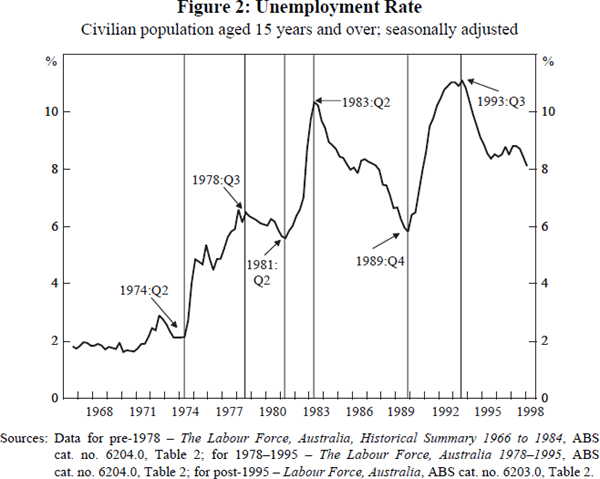
Two main features stand out from this description of changes in the rate of unemployment. First, from a starting point in the early 1970s to the present, there has been an upward trend in the rate of unemployment. Much of this upward shift appears to be accounted for by increases in the rate of unemployment between the mid and late 1970s which were not subsequently reversed. Second, there has been a strong cyclical pattern to changes in the rate of unemployment. The size and speed of increases in unemployment have represented a significant departure from the period prior to the mid 1970s. A further important aspect of cyclical changes has been an asymmetry in the speed of upward and downward adjustment in the rate of unemployment. This is particularly evident in changes in the rate of unemployment during the 1980s.
An alternative perspective on the evolution of the rate of unemployment in Australia can be obtained from studies of the natural rate. Figure 3 shows estimates of the natural rate of unemployment taken from econometric studies. Measures of the natural rate of unemployment are intended to abstract from short-term cyclical fluctuations in the rate of unemployment and hence provide useful information on the ‘permanent’ or ‘general equilibrium’ component of the rate of unemployment (Friedman 1968). The studies summarised in Figure 3 use various approaches to estimate the natural rate of unemployment – for example, estimation of a NAIRU from a Phillips curve; estimation of a structural model for unemployment with steady-state conditions imposed to derive a natural rate of unemployment; and estimation of a Beveridge curve relation with steady-state conditions again imposed to derive the natural rate of unemployment. One problem with estimates of the natural rate of unemployment is that their associated confidence intervals are often extremely large. Nevertheless, the studies shown in Figure 3 present a story that is consistent with the interpretation of movements in the actual rate of unemployment presented above. First, it appears that the natural rate of unemployment increased from around 2 per cent to 6 per cent from the mid 1970s to early 1980s. Second, most studies show the natural rate of unemployment remaining constant or increasing only slightly from the early 1980s onwards. A ‘consensus’ estimate of the natural rate of unemployment in the mid 1990s would appear to be between 6½ and 7½ per cent.
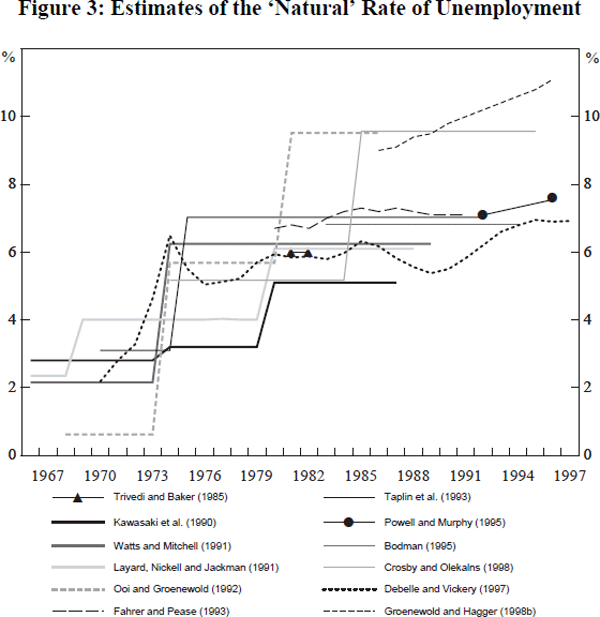
3. Behind the Rate of Unemployment
3.1 Employment and labour force participation
Underlying changes in the rate of unemployment are changes in employment and the labour force. Figure 4 shows long-run trends in these series for males and females. Labour force participation for males and females has moved in opposite directions. For females, the participation rate has increased from 36.6 per cent to 53.6 per cent between August 1966 and February 1998, whereas for males, the participation rate declined from 84.2 to 73.0 per cent over the same period. For males, the employment/population rate also declined – primarily due to decreases in the full-time employment/population rate (from 71.1 per cent to 58.8 per cent between February 1978 and February 1998). At the same time, increases in the part-time employment/population rate for females (from 13.5 per cent to 21.4 per cent between February 1978 and February 1998) have caused a significant rise in the employment/population rate for females.
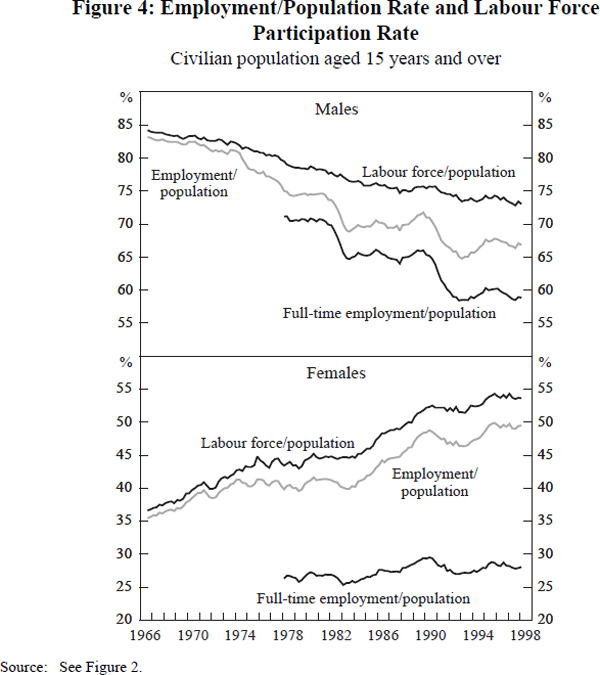
How have these changes in employment/population and labour force participation rates affected the rate of unemployment? To investigate this issue, Table 1 reports the results of a decomposition analysis of the effects on the aggregate rate of unemployment of changes in male and female employment/population and labour force participation rates. For example, the first row in Table 1 shows that between 1974:Q2 and 1978:Q3 the rate of unemployment increased by 4.4 percentage points. Declines in the male full-time employment/population rate over this period would have had the effect – absent any other changes in employment or labour force participation – of increasing the rate of unemployment by 6.6 percentage points.
| Period | Change in rate of UE | Males | Females | |||||
|---|---|---|---|---|---|---|---|---|
| FTE/POP | PTE/POP | LFP/POP | FTE/POP | PTE/POP | LFP/POP | |||
| 1974:Q2–1978:Q3 | +4.4 | +6.6 | −1.3 | −2.4 | +2.3 | −1.6 | +1.0 | |
| 1978:Q3–1981:Q2 | −0.9 | −0.1 | −0.1 | −0.7 | 0.0 | −0.7 | +0.5 | |
| 1981:Q2–1983:Q2 | +4.7 | +5.0 | −0.3 | −1.1 | +1.1 | +0.3 | +0.1 | |
| 1983:Q2–1989:Q4 | −4.5 | −1.1 | −1.3 | −0.8 | −3.4 | −4.1 | +5.7 | |
| 1989:Q4–1993:Q3 | +5.3 | +6.3 | −0.8 | −1.6 | +1.7 | −0.5 | 0.0 | |
| 1993:Q3–1998:Q1 | −2.7 | −0.3 | −1.3 | −0.5 | −0.8 | −1.7 | +1.4 | |
|
Notes: UE denotes unemployment; FTE, full-time employment; PTE, part-time
employment; POP, population; and LFP, labour force. Source: See Figure 2. |
||||||||
A first main finding from the decomposition analysis is that cyclical phases where increases in the rate of unemployment occur have primarily been associated with decreases in the male full-time employment/population rate; on the other hand, in the main cyclical phase where decreases in the rate of unemployment occurred (during the 1980s), the most significant factors affecting the rate of unemployment were large increases in the female full-time and part-time employment/population rates which were offset by significant growth in female labour force participation (see also Gregory 1991).
To investigate the sources of changes in employment across cyclical phases in a little more detail, Table 2 presents changes in employment by industry by gender for selected cyclical phases. Columns (1), (2) and (4) show changes in employment by industry for males during cyclical phases in which increases in the rate of unemployment occurred; and column (3) shows changes in employment by industry for females in the 1980s period where the rate of unemployment decreased. A strong pattern emerges from this table. Declines in employment for males in each downturn have been concentrated primarily in manufacturing, construction and agriculture. For females, employment growth has occurred mainly in trade, finance, community services and personal services industries.
| 1974:Q3 – 1978:Q3 | 1981:Q2 – 1983:Q2 | 1983:Q2 – 1989:Q4 | 1989:Q4 – 1993:Q3 | |
|---|---|---|---|---|
| Males | Males | Females | Males | |
| Industry | (1) | (2) | (3) | (4) |
| A. Total (thousands) | ||||
| Agriculture | −39.9 | −7.1 | 14.1 | −21.7 |
| Manufacturing | −123.9 | −101.8 | 34.7 | −102.0 |
| Construction | −36.8 | −67.2 | 32.6 | −49.3 |
| Wholesale/retail trade | 63.2 | −9.0 | 241.3 | −6.2 |
| Finance, property etc. | 16.6 | 0.9 | 165.0 | −14.6 |
| Community services | 66.6 | −5.5 | 228.6 | 13.8 |
| Recreation, personal services etc. | 5.9 | 2.8 | 115.3 | 11.2 |
| Other | 52.1 | 37.5 | 75.9 | −36.5 |
| B. Percentage | ||||
| Agriculture | −11.9 | −2.2 | 13.5 | −6.9 |
| Manufacturing | −12.3 | −10.7 | 11.4 | −11.3 |
| Construction | −7.6 | −15.3 | 69.5 | −9.3 |
| Wholesale/retail trade | 9.4 | −1.2 | 40.8 | −0.6 |
| Finance, property etc. | 7.1 | 0.2 | 62.0 | −3.1 |
| Community services | 23.7 | −1.4 | 34.9 | 2.8 |
| Recreation, personal services etc. | 4.1 | 1.6 | 52.4 | 4.2 |
| Other | 8.0 | 4.1 | 38.0 | −2.5 |
|
Notes: Data are for 1974:Q3 rather than 1974:Q2, as industry employment information is only available for the August quarter in that year. Data are not seasonally adjusted.
Sources: Data for pre-1978 – The Labour Force, Australia, Historical Summary 1966
to 1984, |
||||
A second finding from Table 1 is that the current period of expansion in the 1990s, although now almost as long as that during the 1980s, has not brought the same magnitude of reduction in unemployment, and in particular, has had much weaker growth in female employment and labour force participation. In fact, had female labour force participation grown at the same rate in the expansion in the 1990s as in the 1980s expansion, it is apparent that the rate of unemployment would now be about 3.5 percentage points higher.
Further detail on outcomes in expansionary periods is presented in Figure 5, which compares the paths of real output and employment of males and females between the expansion during the 1990s (beginning 1993:Q3) and the 1980s expansion (beginning 1983:Q2). Each series is normalised to have a value of 100 at the start of each recovery. The upper panel shows that growth in real Gross Non-farm Product in the 1990s has been below its 1980s path in recent periods, but only slightly so. (Comparisons using real GDP(A) and real GDP(A) per capita are very similar.) The lower panel shows that male employment has evolved at a similar rate in the 1990s to the 1980s; however, growth in female employment has been much slower than during the 1980s – in particular over the past nine quarters.[2]
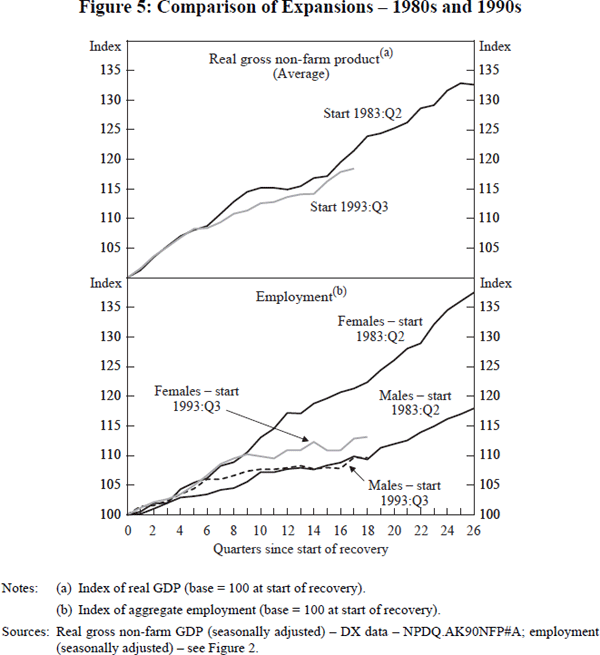
What can explain the slower growth in female employment in the current expansion compared to the 1980s? Possible explanations involve both demand-side and supply-side influences. On the demand side, Figure 5 suggests that a small fraction may be due to slower employment growth across all industries associated with the slightly lower rates of GDP growth. However, much more important would seem to be a set of specific demand-side factors which caused slower employment growth in industries which are female-dominated. Between November 1995 and February 1998, only 46500 extra jobs have been created in the retail, finance/insurance/property, and health and community services industries; whereas female employment increased by around 215500 in these industries in the similar phase of the 1980s expansion (The Labour Force, Australia, 1978–1995, ABS cat. no. 6204.0). This difference can account for about one-half of the difference in total female employment growth between the 1980s and 1990s expansionary phases. The message from these numbers appears to be that female employment has been particularly badly affected by the depressed performance of the retail sector, by downsizing in the finance/insurance industry, and by public sector cutbacks in the health and community services sector.
On the supply side, a number of factors might have played a role. First, it is possible that there has been increasing competition between males and females for part-time jobs. Male part-time employment has grown steadily over the past decade (from 6.6 per cent to 11.5 per cent of total employment between February 1988 and February 1998). Growth in the proportion of males seeking part-time employment has probably been due both to increases in the proportion of younger males in schooling, and to constraints on the availability of full-time jobs for males aged 25–54 years. Second, changes to government benefits during the 1990s – for example, increases in payments to females who are at home looking after children, and reductions in assistance for child-care – may have increased the reservation wage and hence reduced labour supply of females with dependent children. Data on female labour force participation by family status – which show that the phenomenon of slower participation growth has been more pronounced for females in families with dependent children than without dependent children – tend to support this argument. For example, between July 1983 and June 1987, labour force participation of females in families with dependent children rose from 45.2 per cent to 54.1 per cent, whereas between June 1993 and June 1997, participation increased only slightly from 59.6 per cent to 60.9 per cent. Over the same periods, labour force participation of females in families without dependent children increased from 37.1 per cent to 41.0 per cent, and from 45.8 per cent to 48.0 per cent (Labour Force Status and Other Characteristics of Families, Australia, ABS cat. no. 6224.0). Third, reductions in average mortgage repayments since the early 1990s may, through an income effect on labour supply, have caused lower female labour force participation (see Connolly and Spence (1996) for evidence on the effect of home loan ‘affordability’ on female labour supply).
3.2 Labour force flows
Changes in the stocks of persons unemployed provide a ‘point in time’ perspective on the evolution of unemployment. However, any change in stocks which takes place between two points in time will be composed of flows into and out of unemployment which occur in that time interval. This can be seen in the following decomposition of the change in the rate of unemployment between time periods t and t+1:

where It,t+1 and Ot,t+1 are, respectively, inflows to and outflows from unemployment between periods t and t+1, and Ut and Lt unemployment and labour force at period t. Equation (1) shows that changes in the rate of unemployment can be expressed as a function of inflows to and outflows from unemployment as a proportion of the labour force, plus a residual term which depends on the change in the labour force.
Two data sources are available to study flows into and out of unemployment in Australia. First, using monthly data from the ABS Labour Force Survey on numbers of persons unemployed and in the labour force, and on the numbers of persons with unemployment durations of less than or equal to four weeks, it is possible to calculate approximate monthly series of inflows and outflows. Second, data on gross flows using matched records from the ABS Labour Force Survey are also available (Dixon (1998) describes some problems which exist with the latter data source).
Table 3 presents information on flows into and out of unemployment using information from the first data source. Inflows and outflows – in aggregate and for disaggregated gender and age groups – are expressed as a proportion of the total labour force. Hence, following Equation (1), each entry can be read as the per month effect of inflows or outflows on the aggregate rate of unemployment. For example, the entry for males for 1978:Q3–1981:Q2 shows that the average monthly effect of inflows to unemployment by males over this period was to increase the aggregate rate of unemployment by 0.61 percentage points; over the same period the effect of outflows was to lower the aggregate rate of unemployment by 0.63 percentage points per month.
| Average inflow per month | Average outflow per month | Average labour force effect | Average inflow per month | Average outflow per month | ||
|---|---|---|---|---|---|---|
| Persons | 15–19 years | |||||
| 1978:Q3–1981:Q2 | 0.01307 | 0.01316 | −0.00938 | 1978:Q3–1981:Q2 | 0.00437 | 0.00445 |
| 1981:Q2–1983:Q2 | 0.01426 | 0.01222 | −0.00691 | 1981:Q2–1983:Q2 | 0.00441 | 0.00419 |
| 1983:Q2–1989:Q4 | 0.01392 | 0.01439 | −0.01642 | 1983:Q2–1989:Q4 | 0.00427 | 0.00433 |
| 1989:Q4–1993:Q3 | 0.01469 | 0.01346 | −0.00327 | 1989:Q4–1993:Q3 | 0.00405 | 0.00397 |
| 1993:Q3–1997:Q4 | 0.01401 | 0.01441 | −0.01384 | 1993:Q3–1997:Q4 | 0.00380 | 0.00381 |
| Males | 20–24 years | |||||
| 1978:Q3–1981:Q2 | 0.00616 | 0.00630 | 1978:Q3–1981:Q2 | 0.00275 | 0.00280 | |
| 1981:Q2–1983:Q2 | 0.00715 | 0.00570 | 1981:Q2–1983:Q2 | 0.00304 | 0.00262 | |
| 1983:Q2–1989:Q4 | 0.00654 | 0.00687 | 1983:Q2–1989:Q4 | 0.00283 | 0.00292 | |
| 1989:Q4–1993:Q3 | 0.00734 | 0.00649 | 1989:Q4–1993:Q3 | 0.00284 | 0.00267 | |
| 1993:Q3–1997:Q4 | 0.00704 | 0.00732 | 1993:Q3–1997:Q4 | 0.00264 | 0.00271 | |
| Females | 25+ years | |||||
| 1978:Q3–1981:Q2 | 0.00690 | 0.00686 | 1978:Q3–1981:Q2 | 0.00594 | 0.00591 | |
| 1981:Q2–1983:Q2 | 0.00710 | 0.00651 | 1981:Q2–1983:Q2 | 0.00679 | 0.00540 | |
| 1983:Q2–1989:Q4 | 0.00737 | 0.00751 | 1983:Q2–1989:Q4 | 0.00682 | 0.00712 | |
| 1989:Q4–1993:Q3 | 0.00735 | 0.00697 | 1989:Q4–1993:Q3 | 0.00779 | 0.00681 | |
| 1993:Q3–1997:Q4 | 0.00697 | 0.00709 | 1993:Q3–1997:Q4 | 0.00755 | 0.00788 | |
|
Notes: Inflows to unemployment between month t and t+1 are estimated as the number of persons who reported having been unemployed for 4 weeks or less in month t. Outflows from unemployment between months t and t+1 are then estimated as inflows plus unemployment in month t+1 minus unemployment in month t. Sources: Labour Force, Australia, ABS cat. no. 6203.0. Flows into and out of unemployment – information on duration of unemployment (e.g. Table 27 in August 1997) from each monthly publication. Labour force – information on numbers of persons unemployed and on labour force from Figure 2. |
||||||
A number of findings emerge from Table 3. First, inflows and outflows follow a predictable cyclical pattern. Inflows are relatively higher during periods where the rate of unemployment rises, whereas outflows are relatively higher during periods where the rate of unemployment falls. Second, female inflows and outflows are disproportionately large relative to their labour force share; however, cyclical changes in net inflows minus outflows for males are larger than for females. Figure 6 also shows that the average duration of unemployment has displayed – at least until the end of the 1980s – larger cyclical variability for males than females. Third, inflows and outflows for young labour force participants are disproportionately large relative to their labour force share; but cyclical fluctuations – in net inflows minus outflows – are mainly driven by labour force participants aged 25 years and above. Again, Figure 6, which shows little cyclical variation in unemployment of teenage labour force participants, is consistent with this finding.
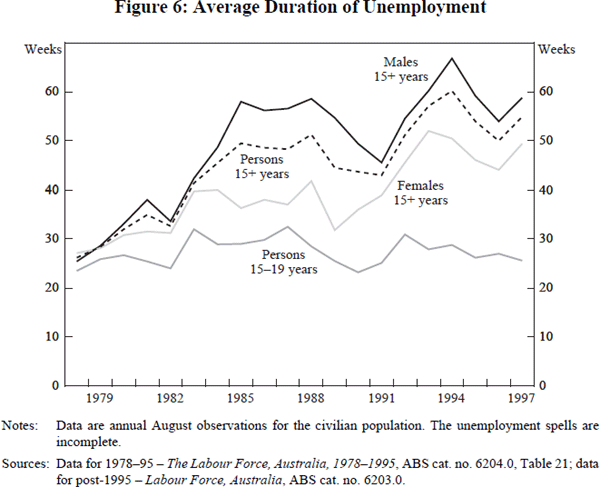
A final point is that there is some evidence of an increase in the sum of aggregate unemployment outflows and inflows for males. To investigate this issue further, Figure 7 uses the second data source to present information on the sum of flows into and out of unemployment from employment and out of the labour force as a proportion of the total labour force. Little change in either series is evident for females; however, for males both series are clearly at a higher level in the 1990s expansion than in the 1980s expansion. On average, about 90,000 extra males are moving into and out of unemployment each month in the 1990s expansion compared to a comparable period in the 1980s. This may represent one factor behind anecdotal evidence of increases in job insecurity in Australia in the 1990s.
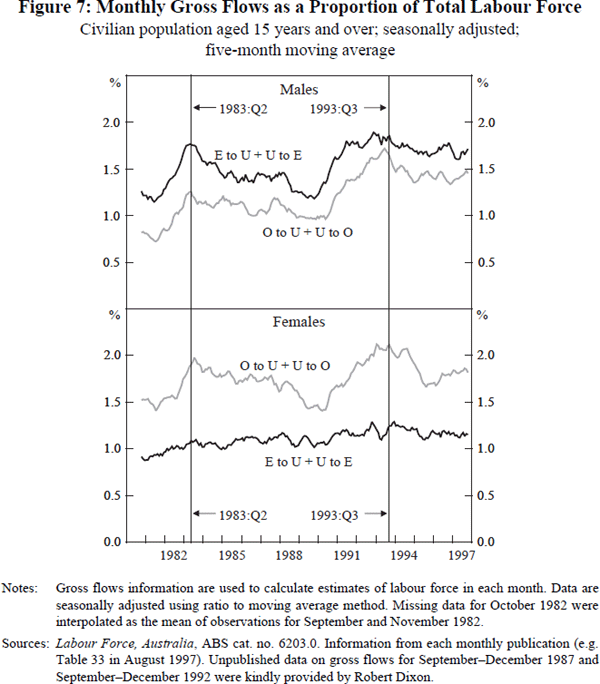
3.3 Hidden unemployment
Conventional unemployment measures do not capture two important dimensions of underutilisation of labour. First, some persons may be in employment but working less hours than they would like. Second, there may be ‘hidden unemployed’ who remain out of the labour force but who would like to be employed. Measuring hidden unemployment as the number of persons who are out of the labour force but report being ‘discouraged workers’, or as the number of persons who are classified as ‘marginally attached to the labour force’, yields estimates of the total rate of unemployment of 9.8 per cent or 16.6 per cent respectively in September 1997 (Persons Not in the Labour Force, Australia, September 1997, ABS cat. no. 6220.0, Table 1). At that time the official rate of unemployment was 8.7 per cent. In addition, recent estimates by Wooden (1996) indicate that the rate of underutilisation of labour in Australia can be estimated as equal to double the rate of unemployment.
3.4 Long-term unemployment
Australia's prolonged experience with high rates of unemployment has meant that attention has focused on the issue of long-term unemployment (e.g. Junankar and Kapuscinski 1991). In February 1998 about 250,000 persons had been unemployed for over a year. This represented approximately thirty per cent of the total group of unemployed persons. Figure 8 shows the relation between the rate of unemployment and rate of long-term unemployment in Australia. It is evident that the two series are strongly correlated with movements in the rate of long-term unemployment slightly lagging movements in the rate of unemployment. Interestingly, it does not appear that – correcting for cyclical factors – there has been any long-run increase in the rate of long-term unemployment (see also EPAC 1996, p. 131). This may suggest that hysteresis-type influences on unemployment associated with the proportion of long-term unemployed (e.g. changes in average search effectiveness) are not likely to have had a significant impact in Australia in the period since the late 1970s. In interpreting Figure 8, it is, however, also important to be aware that policies to alleviate unemployment may have impacted disproportionately on long-term unemployed, and that labour force withdrawal may have been greater amongst long-term than short-term unemployed.
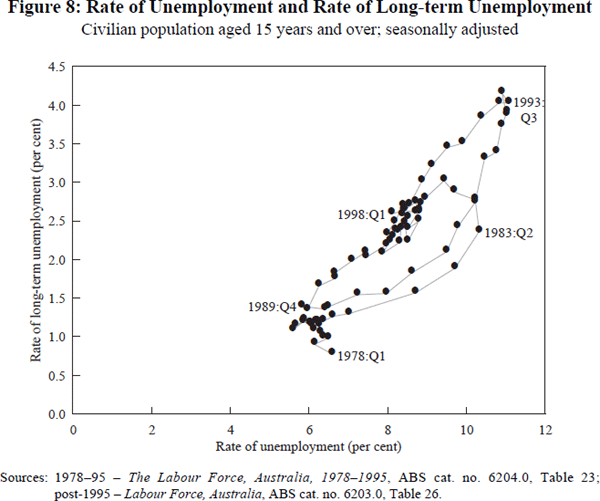
4. The Distribution of Unemployment
4.1 The current situation
The incidence of unemployment in Australia varies between labour force participants with different demographic and skill characteristics. To illustrate this point, Table 4 presents information on the rate of unemployment and distribution of unemployment for a variety of demographic and skill groups. Unemployment is concentrated disproportionately amongst younger and less-educated labour force participants. The incidence of unemployment is also disproportionately high for workers whose last job was as a labourer or tradesperson, and in the manufacturing, construction and accommodation/restaurant/cafe sectors. Unemployment does not appear to be unevenly distributed between Australian-born and immigrant labour force participants; however, within the group of immigrant labour force participants, unemployment is disproportionately concentrated on more recent arrivals. Across family groups, the shares in total unemployment of sole parents, dependent students and non-family members are above their labour force shares, whilst the reverse is the case for partners in couple families. However, recent research by Miller (1997) does show that amongst couple families, a large proportion of total unemployment in the 1990s is accounted for by families where both husband and wife were unemployed.
| Rate of unemployment | Percentage of labour force | Percentage of unemployed | Percentage of long-term unemployed | |
|---|---|---|---|---|
| A. Age | ||||
| Males | ||||
| 15–19 | 22.7 | 4.2 | 10.6 | 4.7 |
| 20–24 | 15.3 | 6.6 | 11.0 | 9.6 |
| 25–34 | 7.8 | 14.2 | 12.3 | 14.1 |
| 35–44 | 6.7 | 14.1 | 10.5 | 27.3 |
| 45–54 | 6.1 | 11.5 | 7.8 | |
| 55–64 | 7.2 | 6.3 | 5.0 | 8.0 |
| Females | ||||
| 15–19 | 21.0 | 4.0 | 9.4 | 4.7 |
| 20–24 | 12.6 | 5.6 | 7.8 | 6.5 |
| 25–34 | 7.4 | 10.7 | 8.7 | 6.1 |
| 35–44 | 7.8 | 10.8 | 9.4 | 16.6 |
| 45–54 | 5.7 | 8.8 | 5.6 | |
| 55–64 | 5.5 | 3.2 | 1.9 | 2.4 |
| B. Education | ||||
| Males | ||||
| Degree | 6.1 | 7.7 | 4.1 | |
| Diploma | 8.0 | 5.4 | 3.9 | |
| Vocational qualification | 8.2 | 16.1 | 11.7 | |
| Completed high school | 13.5 | 9.7 | 11.7 | |
| Not completed high school | 16.3 | 19.1 | 27.8 | |
| Females | ||||
| Degree | 6.3 | 6.3 | 3.1 | |
| Diploma | 5.0 | 5.0 | 2.9 | |
| Vocational qualification | 7.6 | 7.6 | 6.9 | |
| Completed high school | 8.5 | 8.5 | 10.2 | |
| Not completed high school | 14.6 | 14.6 | 17.7 | |
| C. Occupation | ||||
| Manager/administrator | 1.3 | 7.1 | 2.0 | 1.7 |
| Professional | 2.4 | 27.0 | 14.7 | 11.0 |
| Tradesperson | 5.0 | 13.8 | 15.4 | 15.1 |
| Labourer etc. | 9.8 | 10.5 | 23.1 | 28.6 |
| Clerk/salesperson/service worker | 4.0 | 32.1 | 29.3 | 26.6 |
| Production/transport worker | 7.4 | 9.5 | 15.5 | 17.0 |
| D. Industry | ||||
| Agriculture | 5.2 | 5.5 | 6.2 | 5.4 |
| Manufacturing | 6.4 | 13.9 | 19.0 | 22.1 |
| Construction | 5.9 | 7.6 | 9.5 | 12.2 |
| Trade | 4.8 | 21.8 | 22.4 | 20.5 |
| Accommodation etc. | 5.7 | 4.9 | 6.0 | 5.1 |
| Transport/storage | 4.6 | 4.9 | 4.9 | 6.0 |
| Finance, business etc. | 3.7 | 11.0 | 8.7 | 7.9 |
| Government | 4.5 | 4.1 | 4.1 | 6.8 |
| Education/health etc. | 2.4 | 16.3 | 8.4 | 6.9 |
| Personal services | 8.9 | 2.6 | 4.9 | 2.5 |
| Other | 3.6 | 7.4 | 5.9 | 4.6 |
| E. Immigrant status | ||||
| Australian-born | 8.9 | 75.4 | 74.1 | |
| Immigrant | 9.5 | 24.6 | 25.9 | |
| Time of arrival: | ||||
| pre-1976 | 7.1 | 13.9 | 8.8 | |
| 1976–85 | 8.9 | 6.8 | 5.8 | |
| 1986–95 | 12.1 | 6.5 | 8.7 | |
| post-1995 | 17.0 | 1.4 | 2.6 | |
| F. Family status | ||||
| Family | ||||
| Husband/wife | 5.6 | 58.5 | 36.2 | |
| with dependents | 5.7 | 33.8 | 21.6 | |
| without dependents | 5.4 | 24.7 | 14.6 | |
| Sole parent | 17.4 | 4.2 | 8.1 | |
| Dependent student | 18.9 | 4.7 | 9.9 | |
| Non-dependent child | 14.0 | 19.2 | 12.4 | |
| Other family member | 16.3 | 1.6 | 2.9 | |
| Non-family | 11.5 | 15.1 | 19.3 | |
| Other | 11.8 | 3.4 | 4.5 | |
|
Notes: Unemployment rates by education are for the civilian population aged 15 to 69 years in February 1994. Labour force and unemployment by occupation and industry include as employed, all persons employed in the respective occupation or industry at the time of the survey, and as unemployed, all persons who were unemployed at the time of the survey who had worked for at least two weeks full-time in the previous two years and whose last job was in the respective industry or occupation. Sources: Labour Force, Australia, ABS cat. no. 6203.0, February 1998; and Labour Force Status and Educational Attainment, Australia, ABS cat. no. 6235.0, February 1994. |
||||
4.2 Changes over time
Although at any point in time unemployment is likely to be disproportionately concentrated on particular demographic or skill groups of workers, it is not the case that there are groups of labour force participants who have been immune from increases in unemployment. Figure 9 presents information on rates of unemployment for disaggregated age and education groups. Analysis by age indicates that while unemployment rates for younger participants are above those for older participants throughout the period since 1970, and have displayed greater cyclical sensitivity, all groups have experienced increases in unemployment rates. Moreover, taking out the period prior to 1978 the upward trend in unemployment rates has been quite similar between age groups. Analysis by level of educational attainment also reveals increases in the rate of unemployment for all groups – although for those persons with a degree or diploma, increases in the rate of unemployment are largely confined to the most recent downturn.
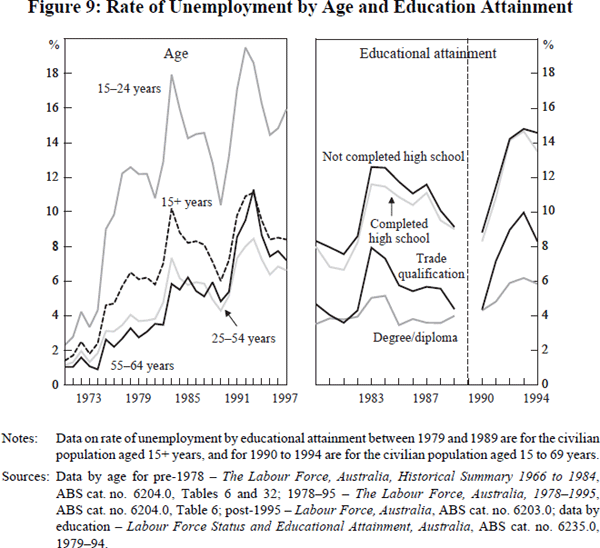
Table 5 reports predicted unemployment probabilities for male and female labour force participants in different age and education categories, and by immigrant status. These probabilities are derived from probit regressions for the determinants of unemployment estimated separately for 1982, 1986, 1990 and 1994/95 using individual-level data on persons aged 25–64 years from the ABS Income Distribution Survey (IDS). Persons aged 15–24 years are excluded to avoid problems associated with large increases in school retention for that age group over the sample period. The ‘base case’ is that of an Australian-born labour force participant with no post-school qualification aged 35–44 years. The findings therefore show, for example, that the probability of unemployment in 1982 for an Australian-born male aged 25–34 with no post-school qualification was 9.1 per cent.
| Year | ||||
|---|---|---|---|---|
| 1982 | 1986 | 1990 | 1994/95 | |
| A. Males | ||||
| Age | ||||
| 25–34 | 0.091(a) | 0.080(a) | 0.090(a) | 0.118(a) |
| 35–44 | 0.055 | 0.056 | 0.067 | 0.085 |
| 45–54 | 0.038(a) | 0.054 | 0.035(a) | 0.085 |
| 55–64 | 0.054 | 0.070 | 0.072 | 0.112(a) |
| Education | ||||
| Degree+ | 0.018(a) | 0.008(a) | 0.016(a) | 0.023(a) |
| Diploma | 0.021(a) | 0.020(a) | 0.039(a) | 0.046(a) |
| Trade qualification | 0.048 | 0.031(a) | 0.038(a) | 0.048(a) |
| No post-school qualification | 0.055 | 0.056 | 0.067 | 0.085 |
| Immigrant status | ||||
| Australian-born | 0.055 | 0.056 | 0.067 | 0.085 |
| United Kingdom | 0.072(a) | 0.096(a) | 0.090(a) | 0.096 |
| Other Europe | 0.091(a) | 0.090(a) | 0.108(a) | 0.091 |
| Asia/Africa | 0.100(a) | 0.209(a) | 0.164(a) | 0.208(a) |
| Americas/Oceania | 0.090(a) | 0.087(a) | 0.087(a) | 0.133(a) |
| B. Females | ||||
| Age | ||||
| 25–34 | 0.081(a) | 0.149(a) | 0.103(a) | 0.096 |
| 35–44 | 0.061 | 0.096 | 0.070 | 0.074 |
| 45–54 | 0.051 | 0.053(a) | 0.055(a) | 0.059 |
| 55–64 | 0.021(a) | 0.095 | 0.047(a) | 0.102(a) |
| Education | ||||
| Degree+ | 0.030(a) | 0.022(a) | 0.027(a) | 0.042(a) |
| Diploma | 0.031(a) | 0.040(a) | 0.047(a) | 0.052(a) |
| Trade qualification | 0.061 | 0.091 | 0.076 | 0.072 |
| No post-school qualification | 0.061 | 0.096 | 0.070 | 0.074 |
| Immigrant status | ||||
| Australian-born | 0.061 | 0.096 | 0.070 | 0.074 |
| United Kingdom | 0.074 | 0.130 | 0.102(a) | 0.068 |
| Other Europe | 0.083 | 0.124 | 0.132(a) | 0.131(a) |
| Asia/Africa | 0.122(a) | 0.191(a) | 0.177(a) | 0.207(a) |
| Americas/Oceania | 0.079 | 0.133 | 0.232(a) | 0.095 |
|
Notes: Data are for persons aged 25–64 who are in the labour force.
Labour force status is defined from the variable ‘employment status
brief’ in 1982, 1990 and 1994/95, and from the variable ‘labour
force status in main and second job’ in 1986. Information on coding
of other explanatory variables is available on request from the authors. Sources: ABS, Income Distribution Survey – Unit-record Files, 1982, 1986, 1990 and 1994/95. |
||||
A number of findings emerge from this analysis. First, increases in the probability of unemployment have occurred for both males and females.[3] (Aggregate-level data show that the rate of unemployment for females was above that of males prior to 1990:Q3, and thereafter has been below the male rate of unemployment.) Second, consistent with Figure 9, it appears that increases (and decreases) in the probability of unemployment tend to occur simultaneously for labour force participants in all age and education groups. Third, for some groups of immigrants, the probability of unemployment is significantly greater than for Australian-born labour force participants. This is particularly the case for immigrants from Asia/Africa.
4.3 Teenage unemployment
The magnitude of teenage unemployment, and its potential long-term consequences, have meant that it has been the subject of much attention (see for example, Wooden 1998). It has already been shown in Table 4 that teenagers account for a disproportionate share of total unemployment. Table 6 provides some further descriptive information on the nature of teenage unemployment in February 1998 by disaggregating between students (high school or tertiary) and non-students, and full-time and part-time labour force participants. It is evident that unemployment amongst students seeking part-time jobs, and non-students seeking full-time jobs, accounts for most of teenage unemployment. Figure 10 presents the rate of unemployment for these groups of teenagers between 1979 and 1997. Rates of unemployment for students seeking part-time jobs and non-students seeking full-time jobs were similar until 1990, but since that time have diverged sharply. The main explanation for this divergence appears to be a rapid decline in full-time employment of teenagers between 1990 and 1992, primarily in manufacturing, retail trade and finance industries.
| Rate of unemployment |
Percentage of labour force |
Contribution to rate of unemployment |
|
|---|---|---|---|
| Students | |||
| Full-time labour force | 34.3 | 3.7 | 1.3 |
| Part-time labour force | 18.8 | 45.5 | 8.6 |
| Non-students | |||
| Full-time labour force | 28.1 | 39.5 | 11.1 |
| Part-time labour force | 7.2 | 11.3 | 0.8 |
| Total | 21.8 | 100.0 | 21.8 |
|
Source: Labour Force, Australia, ABS cat. no. 6203.0, Table 11, February 1998. |
|||
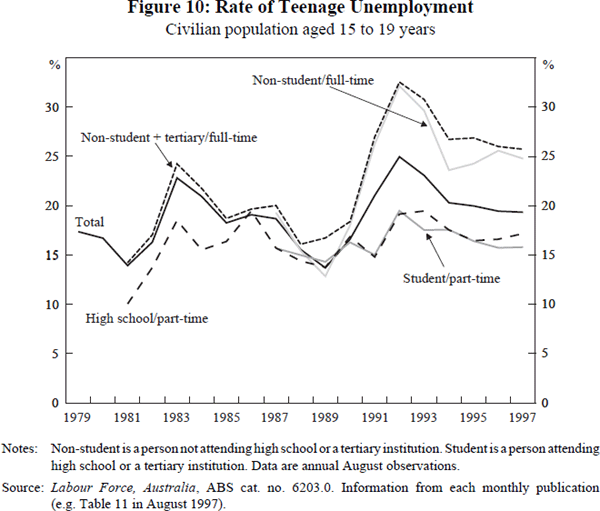
Two other points regarding teenage employment are worth noting. First, the composition of teenage unemployment has changed significantly over time. A much larger share of unemployed teenagers are now students compared to the late 1970s. This is explained by growth in the proportion of teenagers in high school or tertiary institutions, and by increased labour force participation of teenagers who are students. From August 1979 to August 1997, the proportion of teenagers in high school increased from 39.4 per cent to 54.3 per cent, and the labour force participation of teenagers at high school rose from 19.9 to 33.0 per cent. As students are more likely than non-students to be seeking part-time jobs, the proportion of unemployed teenagers seeking part-time jobs has also grown. In August 1979, only 13.0 per cent of unemployed teenagers were seeking part-time jobs, whereas in August 1997, this proportion was 43.5 per cent. Second, there has been some controversy about the appropriate measure of the rate of unemployment for teenagers. Some commentators have, for instance, argued that an appropriate measure should exclude students; another example of a suggested measure of the teenage rate of unemployment is to use unemployed non-students divided by students plus non-student labour force participants. From Table 6 it is obvious that each of these measures would significantly alter the estimated rate of unemployment for teenagers (ABS 1995).
4.4 Regional unemployment
An understanding of regional differentials in unemployment rates is relevant for examining the role of inter-regional labour mobility as an adjustment mechanism in the labour market, and for assessing whether regional factors might constitute a source of hysteresis in unemployment. In Australia understanding the regional dimension involves both inter-state and intra-state comparisons.
Table 7 presents information on changes in rates of unemployment and on the average rate of unemployment in cyclical phases in each state. One feature which emerges is that state-level labour markets move quite closely together with the national market. Consistent with this conclusion, Debelle and Vickery (1998) find that the coefficients of determination between state and national unemployment rates are between 0.75 and 0.9 (using data from 1978 to 1997). The level of the rate of unemployment in each state also generally corresponds quite closely to the national rate – exceptions are Tasmania and South Australia where the rate of unemployment has been consistently above the national rate since 1978.
| Australia | NSW | Victoria | QLD | SA | WA | Tasmania | |
|---|---|---|---|---|---|---|---|
| 1978:Q3 – 1981:Q2 | |||||||
| Change | −0.9 | −1.3 | −0.4 | −1.8 | +0.5 | −0.4 | −1.0 |
| Average | 6.1 | 5.8 | 5.7 | 6.5 | 7.6 | 6.9 | 6.2 |
| 1981:Q2 – 1983:Q2 | |||||||
| Change | +4.7 | +6.0 | +3.9 | +4.9 | +3.5 | +3.9 | +5.9 |
| Average | 7.4 | 7.3 | 6.9 | 7.3 | 8.8 | 7.6 | 8.9 |
| 1983:Q2 – 1989:Q4 | |||||||
| Change | −4.5 | −5.4 | −4.8 | −3.7 | −3.9 | −4.3 | −3.7 |
| Average | 8.0 | 8.4 | 6.7 | 9.1 | 8.9 | 7.9 | 9.5 |
| 1989:Q4 – 1993:Q3 | |||||||
| Change | +5.3 | +5.2 | +8.0 | +4.4 | +2.8 | +4.1 | +4.5 |
| Average | 9.3 | 8.9 | 9.5 | 9.5 | 9.2 | 9.4 | 10.6 |
| 1993:Q3 – 1998:Q1 | |||||||
| Change | −2.7 | −3.1 | −4.8 | −2.2 | −0.3 | −2.2 | −2.9 |
| Average | 9.1 | 8.6 | 9.7 | 9.5 | 9.6 | 7.8 | 10.9 |
|
Sources: Data for 1978–1995 – The Labour Force, Australia, 1978–1995, ABS cat. no. 6204.0, Table 5; for post-1995 – Labour Force, Australia, ABS cat. no. 6203.0, Table 8. |
|||||||
A much greater degree of dispersion exists between regional rates of unemployment within states in Australia. Decomposing the total variance in rates of unemployment in the 186 Department of Employment, Education and Youth Affairs (DEETYA) regions in Australia in June 1997 reveals that more than 90 per cent of the total variance is explained by intra-state variation in rates of unemployment. Some recent analyses have also found that dispersion in regional rates of unemployment has increased over time (e.g. Gregory and Hunter 1996). Increases in dispersion in regional rates of unemployment could provide one source of hysteresis in unemployment – due for example, to neighbourhood effects on the search effectiveness of unemployed persons. To investigate this issue further, Figure 11 presents information on the relation between dispersion in regional rates of unemployment and the average rate of unemployment for 107 DEETYA local labour markets in Victoria between 1984 and 1997.[4] There does not appear to be evidence of any increase in regional dispersion in rates of unemployment beyond that which can be attributed to increases in the average rate of unemployment. This finding is not necessarily inconsistent with earlier research which has found evidence of increasing regional dispersion – because that research has used census data, and the rate of unemployment increased in each inter-censal period from 1976 to 1991. It does however, cast doubt on the role of regional-level factors as a source of hysteresis in unemployment in Australia over the period covered by the DEETYA data.
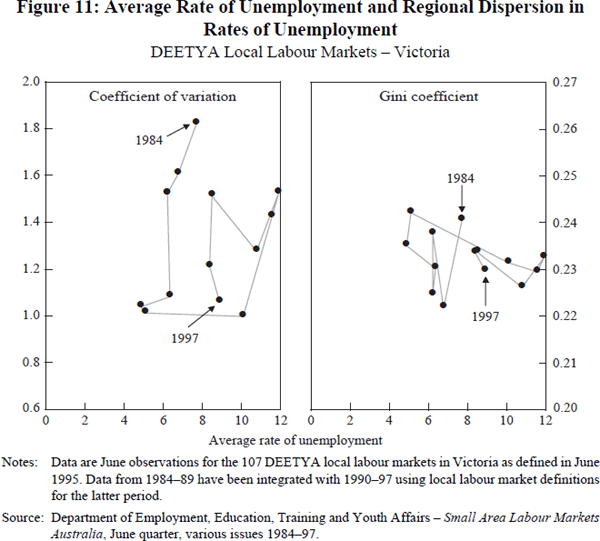
5. Consequences of Unemployment
Why is unemployment of such concern? From society's viewpoint unemployment is undesirable since it represents a waste of resources; further, prolonged periods of high unemployment are likely to be the source of social problems. In this section a range of social consequences of unemployment in Australia are reviewed.[5]
The approach in this section should be seen as ‘partial equilibrium’; for example, it will examine the position of unemployed persons in the distribution of income – but will not make any comment on how the distribution of income might be affected by changes to the rate of unemployment. Two other issues which will arise in the section also require some comment. First, where a statistical relation is found to exist between unemployment and some outcome such as an individual's health status, there remains the question of whether there is an underlying causal relation from unemployment to health status. Second, it is of interest to know whether any effect of unemployment on outcomes such as health status operates only through lower income or through other channels as well. Where evidence on these issues exists it will be described below. However, it should be noted that most available evidence for Australia simply establishes a statistical relation between unemployment and outcomes such as health status, and does not address the issues of causality or transmission mechanism.
5.1 The distribution of income
How does unemployment affect a person's level of income? To answer this question, we examine the location of unemployed persons in the distribution of income using data on annual income in 1993/94 from the 1994/95 ABS IDS. Our analysis replicates that undertaken by Richardson (1998) for 1989/90. In the first step, post-tax equivalent total annual cash income for the respective income unit of each person aged over 15 years is estimated. To calculate equivalent income, OECD equivalence scales – which weight an individual as needing 0.59 of a couple's income to achieve the same standard of living, and assume that each extra child in an income unit increases its needs by 0.29 per person – are applied. In the second step, the distribution of income unit-level equivalent post-tax total annual cash income between individuals is derived, and divided into deciles. The third step is to examine the distribution of unemployed persons by decile in the distribution of income.
Figure 12 presents the findings from this exercise. It is evident that unemployed persons are disproportionately concentrated in the bottom two deciles of the distribution of income. In fact, over one-half of unemployed persons have incomes which place them in these deciles. This result holds using either a sample which includes all persons or which excludes persons who are out of the labour force. Of course, understanding how unemployment affects a person's cash income is only part of the story. To understand the effect on overall well-being it would also be necessary to take into account factors such as non-cash benefits received by unemployed persons, and to adopt a lifetime perspective taking into account, for example, that the experience of unemployment may be associated with lower earnings for unemployed persons who regain employment.
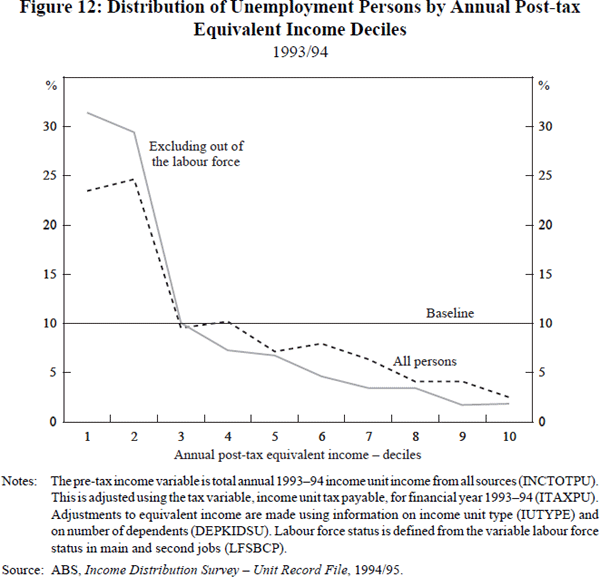
5.2 Crime
Evidence on the relation between labour market outcomes and criminal activity in Australia is somewhat patchy (Weatherburn 1992). A range of time-series analyses of the effect of the aggregate rate of unemployment on criminal activity have generally found no significant effect (e.g. Withers 1984). However, more recent analyses by Bodman and Maultby (1996) which examines the relation between robbery and burglary and the rate of unemployment at the state level from 1982 to 1991, and Kapuscinski et al. (1998) which examines the relation between homicide and the rate of unemployment in Australia from 1921 to 1987, do find a significant positive relation. Regional-level analyses of the relation between the proportion of proven offenders and the rate of unemployment by local government area in Sydney (Devery 1991), and juvenile delinquency and socioeconomic status by postcode area (Weatherburn and Lind 1998) also suggest a positive relation between unemployment and criminal activity. However, issues of causality, and of the transmission mechanism between unemployment and crime, appear as yet to have received little analysis.[6]
5.3 Health
A variety of evidence exists on the relation between unemployment or low income and health outcomes in Australia (Mathers and Schofield 1998; McLelland and Scotton 1998). Aggregate-level evidence exists which shows a positive relation between the rate of unemployment, and heart disease death and youth suicide (Morrell et al. 1998). Individual-level evidence suggests that unemployed persons are likely to use health care services more frequently (Schofield 1996), and self-report lower levels of health (Department of Health, Housing and Community Services 1992, p. 39); and that young unemployed persons have lower levels of psychological health than young employed persons (Morrell et al. 1994). Importantly, the Department of Health, Housing and Community Services study includes a control for the influence of income and still finds an effect of labour force status on health; and the Morrell et al. (1994) study uses longitudinal data from the Australian Longitudinal Survey of Youth and hence is able to establish how a change in employment status for the same person affects health outcomes. Hence, there is some evidence to suggest that unemployment has an adverse causal effect on health outcomes which is only partly due to the effect of lower income.
5.4 Life satisfaction
A number of recent studies have examined the relation between labour force status and ‘happiness’ (e.g. Clark and Oswald (1994), and Darity and Goldsmith (1996)). Here we use data from the International Social Science Survey Program (ISSSP) for Australia in 1994 to undertake a similar type of exercise. Four questions on life satisfaction are selected from the ISSSP and responses recoded to a zero for ‘satisfied’ and one for ‘dissatisfied’. These responses are then summed to create an Index of Life Satisfaction (ILS) which can range between zero (most satisfied) and four (least satisfied) for each individual. Our sample from the ISSSP is persons aged 18–64.
Figure 13 shows the distribution of the ILS by labour force status for the entire sample. Table 8 reports the mean of the ILS by labour force category and the findings from chi-square tests for whether a significant difference exists between the distribution of responses for persons who are employed and unemployed, and out of the labour force and unemployed.
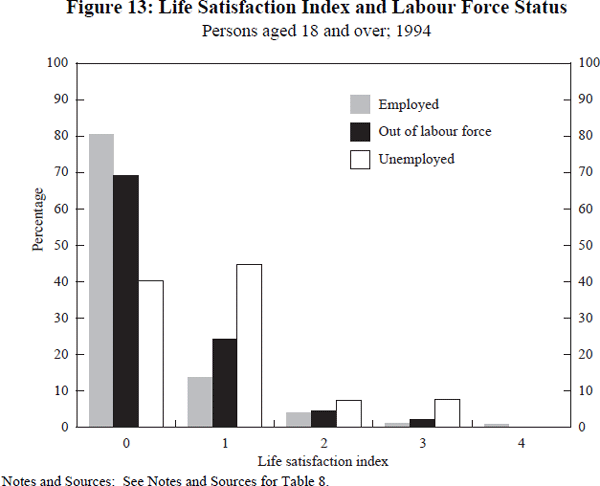
| Mean(a) | Observations | χ2 test(b) | |
|---|---|---|---|
| A. All | |||
| Employed | 0.281 | 838 | 66.67** |
| Out of labour force | 0.392 | 260 | 21.17** |
| Unemployed | 0.820 | 67 | |
| B. Gender | |||
| Males | |||
| Employed | 0.297 | 494 | 29.43** |
| Out of labour force | 0.342 | 70 | 7.97* |
| Unemployed | 0.638 | 47 | |
| Females | |||
| Employed | 0.261 | 340 | 59.60** |
| Out of labour force | 0.410 | 190 | 24.51** |
| Unemployed | 1.250 | 20 | |
| C. Age | |||
| 18–24 | |||
| Employed | 0.300 | 50 | 9.71* |
| Out of labour force | 0.454 | 33 | 4.73 |
| Unemployed | 0.909 | 11 | |
| 25–54 | |||
| Employed | 0.287 | 682 | 52.32** |
| Out of labour force | 0.475 | 141 | 11.22* |
| Unemployed | 0.888 | 45 | |
| 55–64 | |||
| Employed | 0.227 | 88 | 4.68 |
| Out of labour force | 0.214 | 84 | 5.01 |
| Unemployed | 0.400 | 10 | |
|
Notes: (a) The index of life satisfaction is derived from questions on:
How do you feel about your life as a whole?; Your standard of living –
the things you have, like housing, washer, clothes, stereo, car and so
on?; Your income and financial situation?; and Your sense of purpose and
meaning in life? Respondents answering ‘mostly dissatisfied’,
‘unhappy’ or ‘terrible’ were coded as one on each
question; other (more positive) responses were coded as zero. Sources: International Social Science Survey 1994, Kelley et al. (1994), Variables p24q1a, p24q1byy, p24q2ac, p24q2bc, p30q2, p30q3b, p30q3c, p30q 3d, p40q2aa, p40q2c, p70q1a, p70q1b, p70q1c, p70q1d and p70q1h. Further details available on request from authors. |
|||
A number of findings are evident. First, unemployed persons – in aggregate and separately for males and females – report significantly lower life satisfaction than employed persons. The same pattern holds for all age groups except persons aged 55–64 years. Second, unemployed persons report lower levels of life satisfaction than persons out of the labour force – although the difference is not as strong as that between employed and unemployed persons. Third, ordered logit analysis of the determinants of life satisfaction found that – after controlling for age, education, gender, state and weeks unemployed in previous year – an unemployed person had a significantly lower level of life satisfaction than employed persons.[7]
Several caveats, however, must be noted regarding these findings. First, the method of constructing the ILS assumes that inter-personal utility comparisons are possible and imposes particular assumptions about the utility index. Second, it is possible that the relation between unemployment and life satisfaction represents a causal relation from life satisfaction to unemployment or the effect of some other influence on both variables. Third, the regression analysis undertaken was not able to control for income so that the transmission mechanism between unemployment and life satisfaction is unclear.
6. Conclusions
- Unemployment has increased dramatically in Australia since the mid 1970s. Estimates suggest that the natural rate of unemployment has grown from about 2 per cent to 7 per cent over this period. Cyclical changes have involved sharp increases in the rate of unemployment, whereas reductions in the rate of unemployment have taken a much longer time to occur.
- The incidence of unemployment varies between demographic and skill groups in the labour force. Young and less-educated labour force participants, recent immigrants, and persons whose last job was in blue-collar type occupations account for disproportionately high shares of total unemployment. However, all groups have experienced increases in rates of unemployment over the period since the mid 1970s.
- Cyclical phases where increases in the rate of unemployment have occurred have been primarily associated with decreases in the male full-time employment/population rate. During the main phase where the rate of unemployment decreased, the employment/population and labour force participation rates for females increased strongly. Industry-level factors – declining employment in manufacturing and agriculture and increasing employment in finance, trade and the government sector – are behind these changes in male and female employment/population rates.
- The current period of expansion in the 1990s has had much slower growth in female employment and labour force participation than the 1980s expansion. On the demand side, this appears to be mainly due to a set of factors which have caused slower growth in female-dominated industries. On the supply side, it is possible that increasing competition for part-time jobs from male labour force participants, reductions in average mortgage repayments, and changes in government benefits for child care and parenting allowances have played some role.
- In the period since the early 1980s, there does not appear to be strong evidence for a role of hysteresis-type influences on the rate of unemployment operating through lower average search effectiveness of the unemployed or from regional factors.
- Data on labour market flows suggest that there has been an increase in flows into and out of unemployment for males in the 1990s expansion compared with a similar period during the 1980s. Such a shift does not appear to have occurred for females.
- Unemployed persons are concentrated disproportionately at the bottom of the distribution of income. There is also some evidence to suggest that there is a causal relation between unemployment and poor health outcomes, and a little evidence of a relation between criminal activity and unemployment. Unemployed persons appear to have significantly lower levels of ‘life satisfaction’ than other persons.
Footnotes
CEPR, Australian National University, and Analytical Services, Australian Bureau of Statistics respectively. Opinions expressed in this paper are those of the authors and should not be attributed to the Australian Bureau of Statistics. We are grateful to Trevor Breusch, Tom Crossley, Guy Debelle, and in particular to Bob Gregory, for helpful discussions; to Nic Groenewold, Alf Hagger, Boyd Hunter, Cezary Kapuscinski, Frank Morgan, Alison McLelland and Don Weatherburn for assistance with references; to Robert Dixon, Mariah Evans, Don Harding, Ivan Neville, Beth Webster, Richard Webster and the Household Income and Expenditure section of the ABS for assistance in obtaining various pieces of data; and to Yvonne Dunlop and Margi Wood for programming assistance. [*]
Previous reviews of unemployment in Australia are Fahrer and Heath (1992), Goodridge et al. (1995), Dorrance and Hughes (1996), Freebairn (1997), Groenewold and Hagger (1998a), and Debelle and Swann (1998). [1]
Debelle and Swann (1998) also present a comparison of the 1980s and 1990s expansions. That study, however, uses movements in real GDP rather than unemployment to date cyclical phases. Their beginning dates for the expansions are therefore 1983:Q1 and 1991:Q2 rather than 1983:Q2 and 1993:Q3. Comparison of the evolution of the rate of unemployment between expansions is somewhat sensitive to the difference in dating methods. However, the studies have in common the finding that female employment and labour force growth have been significantly weaker in the 1990s than 1980s expansion. [2]
In 1986, the predicted probability of unemployment for females relative to males is much higher than in 1982 or 1990, and higher than would be suggested by aggregate data. However, the pattern whereby female unemployment probabilities tend to be above those for males in 1982 to 1990, and below those for males in 1994/95, is consistent with aggregate-level data from the ABS Labour Force Survey. [3]
DEETYA small area data from 1984 to 1989 used a different definition of local labour markets than between 1990 and 1997. Hence it is necessary to recalculate unemployment rates for local labour markets for 1984 to 1989 based on the later definition. This is a large task – which is why the analysis is restricted to Victoria. However, analysis for other states using data for the period 1990 to 1997 is consistent with the findings for Victoria. [4]
See Junankar and Kapuscinski (1992) for estimates of the output losses associated with periods of high unemployment. [5]
On the latter issue of the transmission mechanism between unemployment and crime, Weatherburn and Lind (1998) present evidence to support the hypothesis that economic distress weakens parental supervision which is in turn responsible for higher rates of juvenile delinquency. [6]
Details of the ordered logit analysis and results are available from the authors on request. Previous regression analysis of the determinants of happiness – undertaken by Travers and Richardson (1993, pp. 119–131) using the Australian Standard of Living survey – did not find a significant relation between unemployment and happiness. An important difference between our study and that of Travers and Richardson is the inclusion of income as an explanatory variable for happiness in the latter study. [7]
References
Australian Bureau of Statistics (1995), ‘Measuring Teenage Unemployment’, Labour Force Australia, cat. no. 6203.0, May, pp. 1–8.
Bodman, P. (1995), ‘Estimating Frictional Unemployment for Australia and its States Using a Stochastic Frontier Approach’, University of Queensland Department of Economics Discussion Paper No. 169.
Bodman, P. and C. Maultby (1996), ‘Crime, Punishment and Deterrence in Australia: A Further Empirical Investigation’, University of Queensland Department of Economics Discussion Paper No. 196.
Clark, A. and A. Oswald (1994), ‘Unhappiness and Unemployment’, Economic Journal, 104(424), pp. 648–659.
Connolly, G. and K. Spence (1996), ‘The Role of Consumer Loan Affordability and Other Factors Influencing Family Decisions in Determining the Female Full-time Participation Rate in the Australian Labour Force’, paper presented at the 25th Conference of Economists, Australian National University, Canberra.
Crosby, M. and N. Olekalns (1998), ‘Inflation, Unemployment and the NAIRU in Australia’, Australian Economic Review, forthcoming.
Darity, W. and A. Goldsmith (1996), ‘Social Psychology, Unemployment and Macroeconomics’, Journal of Economic Perspectives, 10(1), pp. 121–140.
Debelle, G. and T. Swann (1998), ‘Stylised Facts of the Australian Labour Market’, Reserve Bank of Australia Research Discussion Paper No. 9804.
Debelle, G. and J. Vickery (1997), ‘Is the Phillips Curve a Curve? Some Evidence and Implications for Australia’, Reserve Bank of Australia Research Discussion Paper No. 9706.
Debelle, G. and J. Vickery (1998), ‘Labour Market Adjustment: Evidence on Interstate Labour Mobility’, Reserve Bank of Australia Research Discussion Paper No. 9801.
Department of Health, Housing and Community Services (1992), ‘Enough to Make You Sick’, National Health Strategy Research Paper No. 1.
Devery, C. (1991), Disadvantage and Crime in New South Wales, NSW Bureau of Crime Statistics and Research, Sydney.
Dixon, R. (1998), ‘The Gross Flows Data: The Labour Force Survey and the Size of the Matched Sample’, mimeo, University of Melbourne.
Dorrance, G. and H. Hughes (1996), ‘Divided Nation: Employment and Unemployment in Australia’, Melbourne Institute of Applied Economic and Social Research, University of Melbourne, Working Paper No. 8/96.
Economic Planning and Advisory Commission (1996), Future Labour Market Issues for Australia, Economic Planning and Advisory Commission Paper No. 12, AGPS, Canberra.
Fahrer, J. and A. Heath (1992), ‘The Evolution of Employment and Unemployment in Australia’, Reserve Bank of Australia Research Discussion Paper No. 9215.
Fahrer, J. and A. Pease (1993), ‘The Unemployment/Vacancy Relationship in Australia’, Australian Economic Review, 26(4), pp. 43–57.
Freebairn, J. (1997), ‘Unemployment’, in Changing Labour Markets: Prospects for Productivity Growth, Productivity Commission, AGPS, Canberra, pp. 121–145.
Friedman, M. (1968), ‘The Role of Monetary Policy’, American Economic Review, 58(1), pp. 1–21.
Goodridge, S., D. Harding and P. Lloyd (1995), ‘The Long-term Growth in Unemployment’, Melbourne Institute of Applied Economic and Social Research, University of Melbourne, Working Paper No. 2/95.
Gregory, R. (1991), ‘Jobs and Gender: A Lego Approach to the Australian Labour Market’, Economic Record, 67(supplement), pp. 20–40.
Gregory, R. and B. Hunter (1996), ‘Spatial Trends in Income and Employment in Australian Cities’, Report to the Department of Transport and Regional Development.
Groenewold, N. and A. Hagger (1998a), ‘Natural-rate Estimates as a Policy Tool in Australia’, University of Tasmania Centre for Regional Economic Analysis Discussion Paper No. RS–14.
Groenewold, N. and A. Hagger (1998b), ‘The Natural Unemployment Rate in Australia Since the Seventies’, Economic Record, 74(224), pp. 24–35.
Junankar, P. and C. Kapuscinski (1991), ‘The Incidence of Long-term Unemployment in Australia’, Australian Bulletin of Labour, 17(4), pp. 325–352.
Junankar, P. and C. Kapuscinski (1992), The Costs of Unemployment in Australia, Economic Planning Advisory Council Background Paper No. 24, AGPS, Canberra.
Kapuscinski, C., J. Braithwaite and B. Chapman (1998), ‘Unemployment and Crime: Towards Resolving the Paradox’, mimeo, Australian National University.
Kawasaki, K., P. Hoeller and P. Poret (1990), ‘Modelling Wages and Prices for the Smaller OECD Countries’, OECD Department of Economics and Statistics Working Paper No. 86.
Kelley, J., C. Bean, M. Evans and K. Zagorski (1994), International Social Science Survey Program 1994 – User's Guide and Data File, Social Science Data Archives, Australian National University, Canberra.
Layard, R., S. Nickell and R. Jackman (1991), Unemployment: Macroeconomic Performance and the Labour Market, Oxford University Press, Oxford.
Mathers, C. and D. Schofield (1998), ‘The Health Consequences of Unemployment: The Evidence’, Medical Journal of Australia, 168(4), pp.178–182.
McLelland, A. and R. Scotton (1998), ‘Poverty and Health’, in R. Fincher and J. Nieuwenhuysen (eds), Australian Poverty: Then and Now, University of Melbourne Press, Melbourne, pp. 185–202.
Miller, P. (1997), ‘The Burden of Unemployment on Family Units: An Overview’, Australian Economic Review, 30(1), pp. 16–30.
Morrell, S., R. Taylor and C. Kerr (1998), ‘Unemployment and Young People's Health’, Medical Journal of Australia, 168(5), pp. 236–240.
Morrell, S., R. Taylor, S. Quine et al. (1994), ‘A Cohort Study of Unemployment as a Cause of Psychological Disturbance in Australian Youth’, Social Sciences and Medicine, 38(11), pp. 1553–1564.
Ooi, H. and N. Groenewold (1992), ‘The Causes of Unemployment in Australia’, Australian Economic Papers, 31(1), pp. 77–93.
Powell, A. and C. Murphy (1995), Inside a Modern Macroeconomic Model – A Guide to the Murphy Model, Springer-Verlag, Berlin.
Richardson, S. (1998), ‘Who Gets Minimum Wages?’, Australian National University Centre for Economic Policy Research Discussion Paper No. 386.
Schofield, D. (1996), ‘The Impact of Employment and Hours of Work on Health Status and Health Service Use’, University of Canberra National Centre for Social and Economic Modelling Discussion Paper No. 11.
Taplin, B., P. Jilek, L. Antioch, A. Johnson, P. Parameswaran and C. Louis (1993), ‘Documentation of the Macroeconomic (TRYM) Model of the Australian Economy’, TRYM Paper No. 2, Commonwealth Treasury.
Travers, P. and S. Richardson (1993), Living Decently: Material Well-being in Australia, Oxford University Press, Melbourne.
Trivedi, P. and G. Baker (1985), ‘Equilibrium Unemployment in Australia: Concepts and Measurement’, Economic Record, 61(174), pp. 629–643.
Watts, M. and W. Mitchell (1991), ‘Alleged Instability of the Okun's Law Relationship in Australia: An Empirical Analysis’, Applied Economics, 23(12), pp. 1829–1838.
Weatherburn, D. (1992), ‘Economic Adversity and Crime’, Trends and Issues No. 40, Australian Institute of Criminology.
Weatherburn, D. and B. Lind (1998), ‘The Developmental Antecedents of Crime-prone Neighbourhoods’, paper presented at NSW Child Protection Council State Conference.
Withers, G. (1984), ‘Crime, Punishment and Deterrence in Australia: An Empirical Investigation’, Economic Record, 60(2), pp. 176–185.
Wooden, M. (1996), ‘Hidden Unemployment and Underemployment: Their Nature and Possible Impact on Future Labour Force Participation and Unemployment’, National Institute of Labour Studies Working Paper No. 140.
Wooden, M. (1998), ‘The Labour Market for Young Australians’, in Australia's Youth: Reality and Risk, Dusseldorp Skills Forum, Sydney, pp. 31–50.

 where φ
is the normal probability density function, and
V is the variance-covariance matrix from the probit regression
equation for unemployment.
where φ
is the normal probability density function, and
V is the variance-covariance matrix from the probit regression
equation for unemployment.